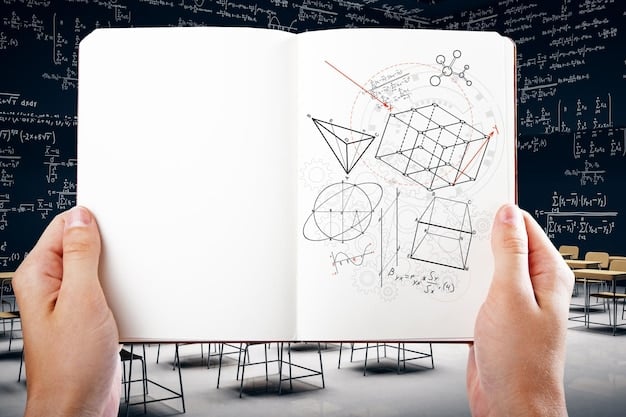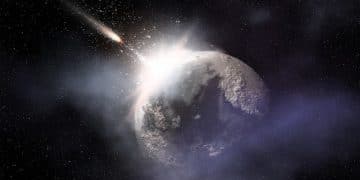Fifth Fundamental Force: Reshaping US Physics Texts

The emergence of compelling new evidence suggesting a fifth fundamental force has profound implications for the established framework of physics, particularly in how concepts are presented and taught within US university textbooks, prompting a necessary re-evaluation of foundational principles and experimental methodologies.
The universe, as we understand it, is governed by four fundamental forces: gravity, electromagnetism, and the strong and weak nuclear forces. These pillars have long formed the bedrock of modern physics curricula, yet recent groundbreaking discoveries are challenging this very foundation. A new wave of compelling evidence suggesting a fifth fundamental force has emerged, poised to reshape not just theoretical physics but also the way its principles are conveyed and internalized at the university level. How will this potential paradigm shift fundamentally alter physics textbooks in US universities?
The Established Canon: Four Forces and Their Domain
The current understanding of the universe operates under the Standard Model of particle physics, which brilliantly describes three of the four known fundamental forces: the strong, weak, and electromagnetic forces. Gravity, while profoundly impactful, remains a unique challenge, elegantly described by Einstein’s theory of general relativity but yet to be fully integrated seamlessly with quantum mechanics within this model. This foundational structure has provided a robust framework for understanding phenomena from the subatomic to the cosmological scale, from the binding of quarks in protons to the formation of galaxies. Its success is undeniable, guiding countless experiments and predictions that have consistently proven accurate. Academic institutions across the United States have meticulously structured their physics curricula around these principles.
Decades of Discovery and Delineation
For decades, physics education in US universities has faithfully adhered to this four-force model. Textbooks meticulously detail the properties, mediators (like photons for electromagnetism or gluons for the strong force), and ranges of each force. Students delve into electromagnetism’s role in everything from light bulbs to complex circuits, the strong force’s binding of atomic nuclei crucial for modern energy, and the weak force’s involvement in radioactive decay, pivotal for understanding stellar processes. Gravity, often introduced separately initially, eventually finds its sophisticated place as the curvature of spacetime.
The curriculum progression often starts with classical mechanics, where gravity is the initial focus, followed by electromagnetism, then moving into the quantum realm to explore the strong and weak forces. This systematic approach ensures a comprehensive understanding of how these forces interact and shape the physical world.
- Gravity: Governs large-scale structures, celestial mechanics, and spacetime curvature.
- Electromagnetism: Responsible for light, electricity, magnetism, and chemical bonds.
- Strong Nuclear Force: Binds protons and neutrons in atomic nuclei.
- Weak Nuclear Force: Mediates radioactive decay and nuclear fusion processes.
The robustness of this framework has allowed for incredible technological advancements and a deeper appreciation of the universe’s intricate workings. Physics students dedicate years to mastering these concepts, performing experiments that validate their existence and properties. The very notion of a “fifth force” challenges this deeply ingrained and extensively validated understanding, necessitating a re-examination of every established principle.
This established canon, while immensely successful, is not without its tantalizing anomalies and unanswered questions. Dark matter and dark energy, for instance, hint at interactions or particles beyond the Standard Model. It is within these liminal spaces that the possibility of a new fundamental force emerges, pushing the boundaries of current knowledge and promising a revolution in our understanding of physics.
The Whispers of a New Interaction: Evidence Unfolds
In the realm of fundamental physics, the prospect of discovering a fifth force is nothing short of revolutionary. For years, subtle anomalies in experimental results have hinted at an interaction beyond the established four. These whispers, initially faint and easily dismissed as experimental noise, have grown louder and more persistent, coalescing into compelling evidence that commands serious attention from the scientific community.
Muons and Magnetic Moments: The Fermilab Anomaly
Perhaps the most significant recent development stems from experiments involving muons, ephemeral cousins of electrons. The Muon g-2 experiment at Fermilab, which precisely measures the magnetic moment of muons, has yielded results that diverge significantly from the predictions of the Standard Model. This deviation, now reaching a statistical significance of 5 sigma – the gold standard for a discovery in particle physics – strongly suggests that muons are experiencing an interaction not accounted for by our current understanding.
The magnetic moment of a muon, often denoted as ‘g-2’, is a quantum property that dictates how it behaves in a magnetic field. Theoretical calculations based on the Standard Model predict a very specific value for this parameter. However, the experimental measurements from Fermilab, building on previous insights from Brookhaven National Laboratory, consistently show a slight but undeniable difference. This discrepancy, while minuscule, hints at a guiding force or particle that interacts with muons but not necessarily with electrons or other fundamental particles in the same way, leading physicists to hypothesize the existence of a new force carrier, potentially a “dark photon” or a similar exotic particle.
- Experimental Precision: The g-2 experiments employ extremely precise techniques to minimize errors.
- Theoretical Rigor: Standard Model predictions are meticulously calculated by large collaborations.
- Consistent Discrepancy: The observed deviation has been consistent across multiple experiments.
Beyond Fermilab, other research avenues are contributing to this intriguing narrative. Anomalies in ultra-light dark matter searches, observed decays of excited helium nuclei, and even subtle deviations in gravitational measurements at short distances have provided additional, albeit less statistically robust, hints. While each piece of evidence on its own might be inconclusive, their collective weight painted an increasingly persuasive picture. Researchers across various disciplines are now actively pursuing these leads, designing new experiments and re-evaluating existing data with the possibility of a fifth force firmly in mind.

The careful and rigorous re-analysis of these findings, combined with ongoing and planned experiments, will be crucial in confirming or refuting the existence of this potential fifth fundamental interaction. This scientific process, characterized by skepticism and meticulous verification, underscores the cautious optimism that permeates the high-energy physics community. The implications of a confirmed discovery would be far-reaching, fundamentally altering our cosmic perspective.
The Theoretical Underpinnings: What Could It Be?
If a fifth fundamental force indeed exists, its theoretical characteristics become the next crucial puzzle piece. Physicists are not just looking for evidence of a new force, but also trying to understand its nature: what particles mediate it, what is its range, and how does it interact with known matter? Several theoretical models have been proposed, each attempting to explain the observed anomalies and integrate a new interaction into the existing framework of particle physics.
Mediators and Ranges: Exploring New Bosons
The Standard Model describes fundamental forces as being mediated by specific particles called bosons. For instance, the photon mediates the electromagnetic force, and gluons mediate the strong force. A new force would similarly require a new type of boson. Researchers speculate about a “dark photon,” a hypothetical fundamental particle that might mediate a new, subtle interaction between dark matter and ordinary matter, or even between ordinary matter particles in ways not yet discovered.
The range of a force is determined by the mass of its mediating particle. If the mediating particle is massless, like the photon, the force has an infinite range. If it has mass, the force has a finite, short range. The subtle nature of the anomalies observed so far suggests that if a new force exists, it likely has a very short range, implying its mediating particle might be relatively heavy. This hypothetical new boson could interact weakly with known particles while interacting more strongly with undiscovered dark matter particles, potentially explaining why it has eluded direct detection for so long.
- Dark Photons: Hypothetical mediator of dark forces, interacting weakly with known matter.
- Axions: Proposed solutions for problems in quantum chromodynamics, could mediate a very weak, short-range force.
- “X17” Boson: A proposed particle linked to anomalies in radioactive decays of excited helium nuclei, potentially mediating a fifth force related to dark matter.
The existence of such a particle could also help resolve some of the persistent mysteries of the universe, such as the nature of dark matter. If dark matter interacts through a fifth force, this could explain why it has been so difficult to detect, as its interactions with known matter would be extremely weak. These theoretical models are not arbitrary; they are constrained by existing experimental data and built upon the rigorous foundations of quantum field theory. The search for a fifth force is thus intimately linked with the quest to understand dark matter and dark energy, the invisible components that make up the vast majority of our universe.
Scientists are also exploring connections to phenomena like neutrino oscillation, the hierarchy problem of particle masses, and cosmic inflation, all of which hint at physics beyond the Standard Model. The true nature of this potential fifth force, if confirmed, will profoundly influence our understanding of fundamental interactions and the very fabric of reality.
Impact on Physics Curricula: A Paradigm Shift for Textbooks
The potential confirmation of a fifth fundamental force would not merely be an addition to our knowledge; it would represent a significant paradigm shift, necessitating a profound overhaul of how fundamental physics is taught, particularly within US university curricula. Textbooks, which are the bedrock of physics education, would require extensive revision to integrate this new understanding, impacting everything from introductory courses to advanced research topics.
Rewriting Foundations: From Four to Five
Currently, every introductory physics textbook in the US begins with the implicit or explicit assumption of four fundamental forces. Chapters are structured around their properties, interactions, and experimental evidence. A confirmed fifth force would immediately mandate a re-evaluation of this foundational principle. Textbooks would need to incorporate a new chapter or section dedicated to the discovery, its theoretical basis, and its implications. This would mean revising fundamental equations, re-explaining interactions, and even potentially re-interpreting historical experiments through a new lens.
The implications extend beyond just adding a new force. The existence of a fifth force might necessitate a re-examination of other established theories. For example, if the new force interacts with dark matter, it could change our understanding of cosmological models and the evolution of the universe. This would lead to revisions in astrophysics and cosmology courses, and the textbooks supporting them.
- Introductory Physics: Chapters on fundamental forces would be expanded.
- Quantum Mechanics: New interaction terms might need to be introduced.
- Particle Physics: Entire sections on the Standard Model would be updated to include new particles and interactions.
- Astrophysics/Cosmology: Implications for dark matter and dark energy models would be discussed.
Moreover, the pedagogical approach might shift. Rather than simply presenting the four forces as given, textbooks might emphasize the dynamic and incomplete nature of scientific discovery, highlighting how new evidence can challenge long-held beliefs. This would foster a more critical and inquisitive mindset among students, preparing them for a field that is constantly evolving.

The process of updating textbooks would be a massive undertaking, involving collaboration between experimentalists, theorists, and physics educators. It would require careful consideration of how to present complex new concepts in an accessible yet rigorous manner. The updated textbooks would reflect a more accurate and complete picture of the universe, setting the stage for future generations of physicists to build upon this groundbreaking discovery.
Challenges and Opportunities for US University Education
The integration of a fifth fundamental force into physics curricula in US universities presents both significant challenges and unparalleled opportunities. Adapting established teaching methods and materials to accommodate a radical new scientific discovery will require concerted effort, but it also promises to invigorate physics education and research.
Faculty Training and Curriculum Development
One of the primary challenges will be retraining and re-educating faculty members. Many professors, especially those whose foundational physics education predates this discovery, will need to update their knowledge base and teaching methodologies. Workshops, seminars, and new course materials will be essential to ensure that faculty are well-versed in the latest theoretical models and experimental findings related to the fifth force. This comprehensive update of expertise will then trickle down to student learning.
Curriculum development will also be a complex task. Departments will need to decide at what level the new force should be introduced. Should it be mentioned in introductory physics courses? Should dedicated advanced courses be created? How will it integrate with existing quantum mechanics, particle physics, and cosmology curricula without overloading students? These decisions will require careful planning to maintain a coherent and progressive learning path.
- Resource Allocation: Funding for new research and teaching materials.
- Interdisciplinary Collaboration: Engagement with materials scientists and engineers.
- Staying Current: Mechanisms for continuous updates as the field evolves.
However, these challenges come with immense opportunities. The discovery of a fifth force could significantly boost student interest in physics. The excitement of being on the frontier of human knowledge, studying a universe that is still revealing its fundamental secrets, can be a powerful motivator. This could lead to an increase in physics enrollments and a more vibrant research community.
Furthermore, the need to explore and understand a new fundamental force will open up entirely new avenues for research projects for both faculty and students. New experimental techniques might need to be developed, and innovative theoretical frameworks will be required. This could foster a new generation of physicists who are adept at tackling complex, uncharted scientific territories, pushing the boundaries of what is known and understood. The very process of adapting to such a groundbreaking discovery reinforces the dynamic and ever-evolving nature of scientific inquiry, preparing students for a future where new discoveries continually reshape our understanding.
Beyond the Classroom: Societal and Technological Implications
The potential discovery of a fifth fundamental force extends its influence far beyond the confines of academic textbooks and university classrooms. Such a monumental shift in our understanding of the universe could ripple through society, influencing everything from technological innovation to philosophical perspectives on existence.
Catalyst for New Technologies
Historically, advancements in fundamental physics have often paved the way for unforeseen technological revolutions. The discovery of electromagnetism led to electricity, electronics, and telecommunications. Understanding nuclear forces unlocked nuclear energy and medical imaging. Similarly, a confirmed fifth force, particularly if it involves new particles or interactions, could be a catalyst for entirely new technologies. While immediate applications might not be obvious, the deeper comprehension of fundamental interactions could open doors to novel energy sources, communication methods, or even propulsion systems that are currently unimaginable.
For instance, if the fifth force interacts with dark matter, it might provide avenues for detecting or even manipulating this mysterious substance, leading to breakthroughs in areas that are currently purely speculative. New instrumentation would inevitably be developed to explore and measure this force, leading to spin-off technologies applicable in various industrial sectors. The precision required to detect subtle deviations from known physics often leads to advancements in measurement science and engineering that have broader benefits.
- Particle Accelerators: Design of next-generation colliders to probe new forces.
- Detector Technology: Development of more sensitive sensors for exotic particles.
- Quantum Computing: Potential for new qubits based on novel particle interactions.
- Space Exploration: New propulsion concepts, if the force allows for it.
The economic impact could be significant, similar to how the internet or semiconductor industries emerged from fundamental research. Governments and private entities might invest heavily in research and development to harness the potential of this new force, creating jobs and fostering innovation. This broad societal engagement would further underscore the importance of basic scientific research, demonstrating its long-term benefits to humanity.
On a more profound level, a fifth force would provoke new philosophical inquiries about the nature of reality and our place within the cosmos. It would challenge established models of fine-tuning and the anthropic principle, pushing humanity to rethink some of its deepest questions. The interplay between scientific discovery and societal evolution is a dynamic one, where each influences the other in unforeseen ways, and the revelation of a fifth fundamental force would be a prime example of this intricate dance.
The Collaborative Future: Accelerators, Theory, and Education
The journey to confirm and fully understand a fifth fundamental force is a collective endeavor, requiring unprecedented collaboration across various scientific disciplines. Particle physicists, astrophysicists, cosmologists, and educational reformers will all play crucial roles in shaping this new era of discovery. The future of physics, in light of a potential fifth force, rests on the synergistic interplay between cutting-edge experimental facilities, rigorous theoretical development, and an adaptable educational system.
Global Experimental Efforts
The Muon g-2 anomaly is just one piece of the puzzle. Confirming a fifth force will necessitate a robust portfolio of experiments worldwide. Future particle accelerators, such as potential next-generation colliders, will be instrumental in probing higher energy scales and searching for new particles that could mediate this force. Complementary experiments focusing on precision measurements at lower energies, searching for subtle deviations in gravitational interactions, or exploring the properties of exotic atomic systems, will also be vital. Groups like the European Organization for Nuclear Research (CERN), Fermilab, and various university-led consortia will continue to lead these complex investigations, pooling resources and expertise.
Dark matter detection experiments, both direct and indirect, will also be re-evaluated through the lens of a fifth force, as a new interaction could strongly influence how dark matter behaves and how it might be detected. The global nature of these endeavors ensures a broad range of scientific perspectives and the highest standards of verification, which are crucial for a claim of such magnitude.
- International Collaborations: Pooling resources and expertise across borders.
- Data Sharing: Open access to experimental results for independent verification.
- Funding for Research: Sustained investment in fundamental physics.
The role of theoretical physicists will be equally indispensable. As experimental evidence mounts, theorists will refine existing models and develop new ones to explain the observed phenomena. They will work to integrate the fifth force into a more comprehensive framework, potentially leading to a “Theory of Everything” that unifies all fundamental interactions. This theoretical work will guide future experiments, creating a virtuous cycle of discovery and understanding.
Finally, and critically, the educational community must be prepared to adapt. Universities and textbook publishers will lead the charge in disseminating this new knowledge to future generations. This preparedness involves not only updating content but fostering an environment that encourages critical thinking, an appreciation for the iterative nature of science, and the courage to challenge established paradigms. The collaborative efforts across these fronts will define how quickly and effectively humanity embraces this next frontier in fundamental physics.
| Key Aspect | Brief Description |
|---|---|
| ⚛️ Muon g-2 Anomaly | Experiment at Fermilab shows muons’ magnetic moment deviates from Standard Model predictions, strongly hinting at new physics. |
| 📚 Textbook Revisions | US university physics textbooks would require major updates, shifting from four to five fundamental forces, impacting all levels of learning. |
| 🔬 New Research Avenues | Discovery would spur new theoretical models, experimental designs, and interdisciplinary collaborations to understand the force’s nature. |
| 💡 Broader Impact | Potential for unforeseen technological advancements and deeper philosophical insights into the universe’s fundamental workings. |
Frequently Asked Questions About the Fifth Fundamental Force
▼
The most compelling evidence comes from the Muon g-2 experiment at Fermilab, which shows a significant deviation in the muon’s magnetic moment from Standard Model predictions. This anomaly suggests an unknown interaction influencing muons, hinting at a force beyond the four currently known fundamental forces, driving extensive research and theoretical speculation.
▼
Textbooks would undergo substantial revisions. Introductory chapters on fundamental forces would expand from four to five, requiring updates to theoretical frameworks, experimental discussions, and historical context. This change would permeate advanced courses in particle physics, quantum mechanics, and cosmology, necessitating new sections and potentially re-evaluating existing concepts to accommodate the new force.
▼
The proposed mediator for a fifth force is hypothesized to be a new type of boson, often referred to as a “dark photon” or an “X17 boson.” Its properties, such as mass and interaction strength, would determine the range and characteristics of the force. These particles would interact weakly with known matter but potentially more strongly with dark matter.
▼
Beyond the Muon g-2 anomaly, subtle hints include observed anomalies in the decays of excited helium nuclei, which suggest a new light particle (the X17 boson). Additionally, some short-range gravitational experiments and certain dark matter search results have presented slight deviations from predictions, though these are less statistically significant than the Fermilab findings.
▼
Confirmation would open entirely new avenues for scientific research, potentially leading to unprecedented technological advancements, from novel energy sources to new propulsion systems. It would deepen our understanding of dark matter and energy, reshape our cosmological models, and fundamentally alter humanity’s perception of the universe’s underlying structure, fostering new philosophical inquiries.
Conclusion
The tantalizing evidence for a fifth fundamental force represents a thrilling chapter in the ongoing quest to understand the universe. While the scientific process demands further rigorous verification, the implications of such a discovery are profound. Physics textbooks in US universities stand on the cusp of an unprecedented revision, signaling a shift from a four-force paradigm to a more comprehensive understanding of nature’s fundamental interactions. This potential scientific revolution promises to not only reshape academic curricula but also ignite new research frontiers, inspiring a new generation of physicists to explore the cosmos with fresh eyes and a renewed sense of wonder. The coming years will be crucial as experiments refine their measurements and theorists continue to build frameworks for this potentially groundbreaking reality.





